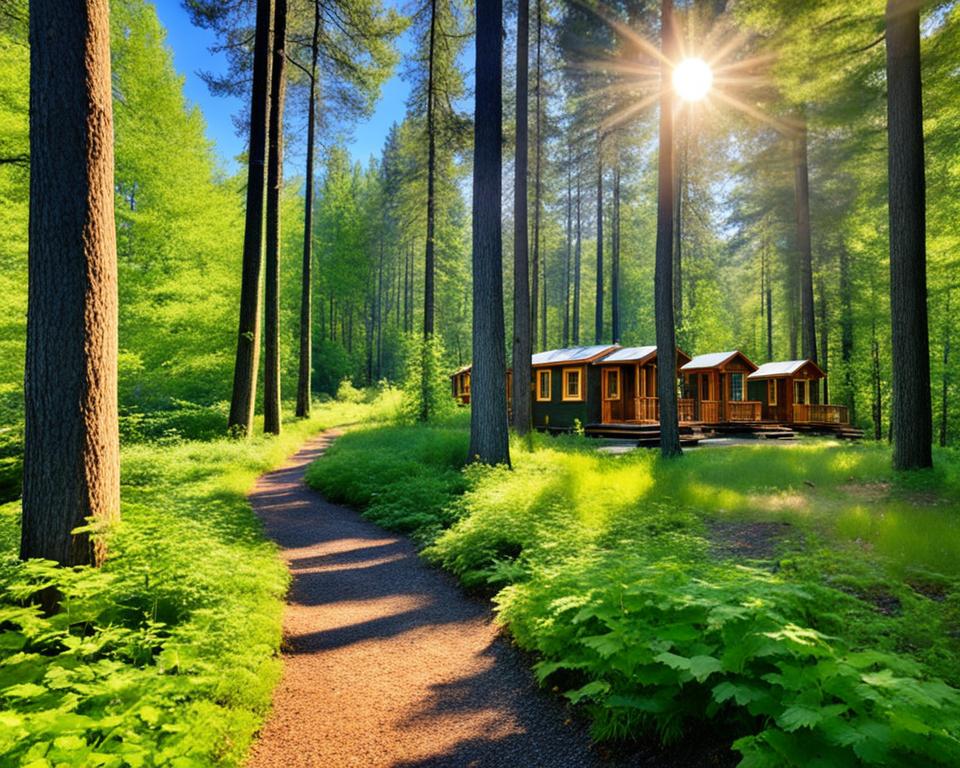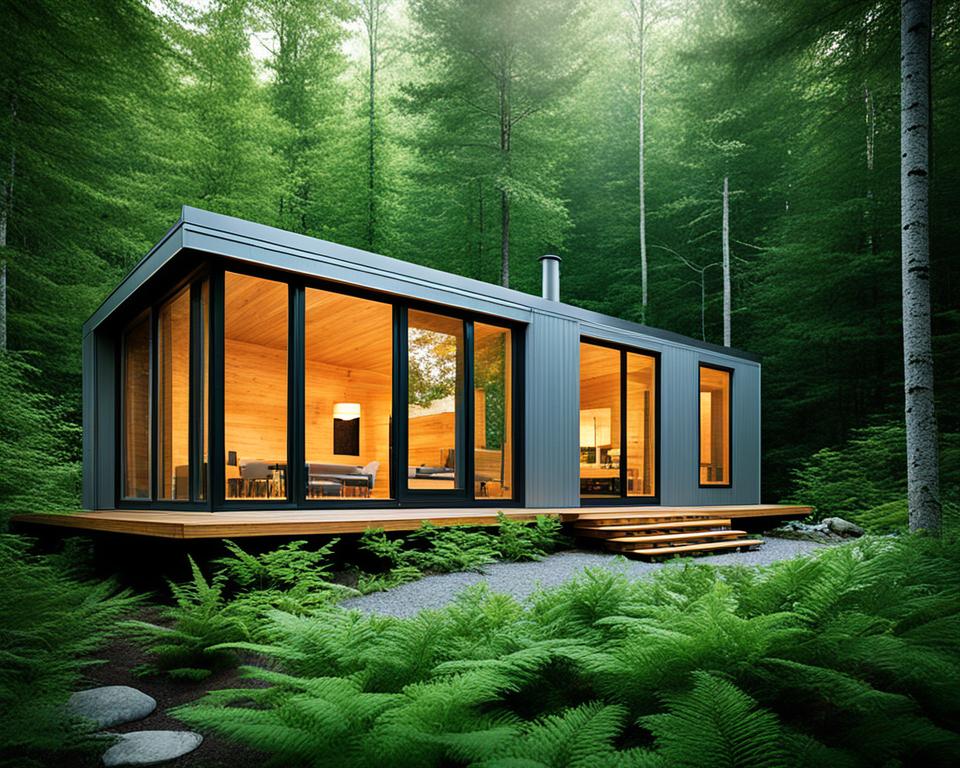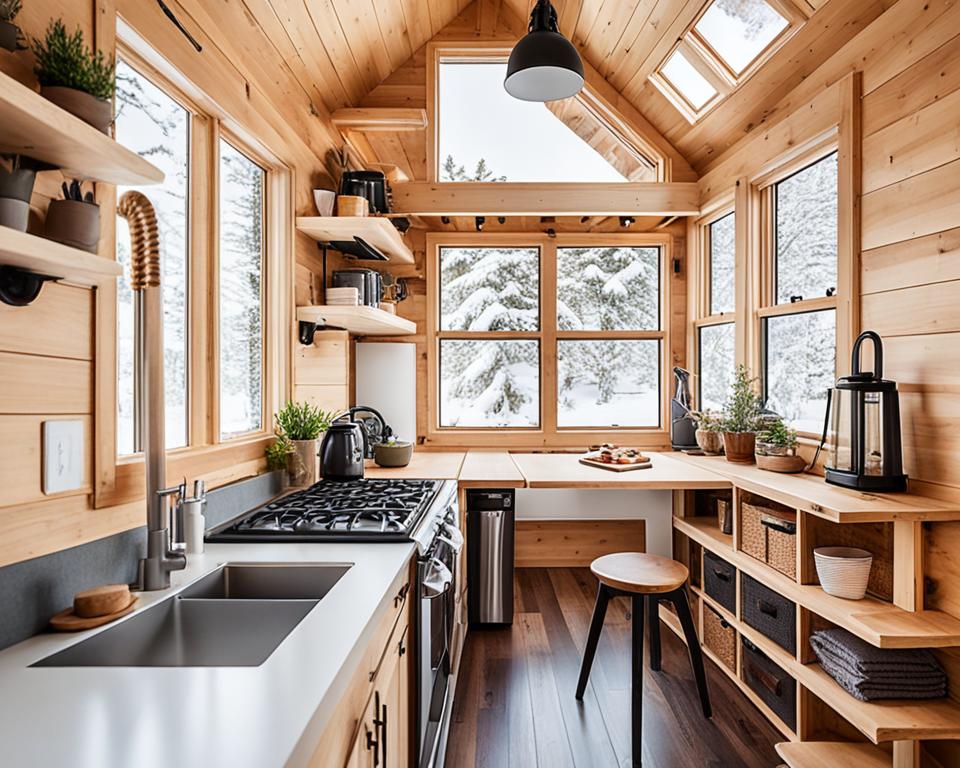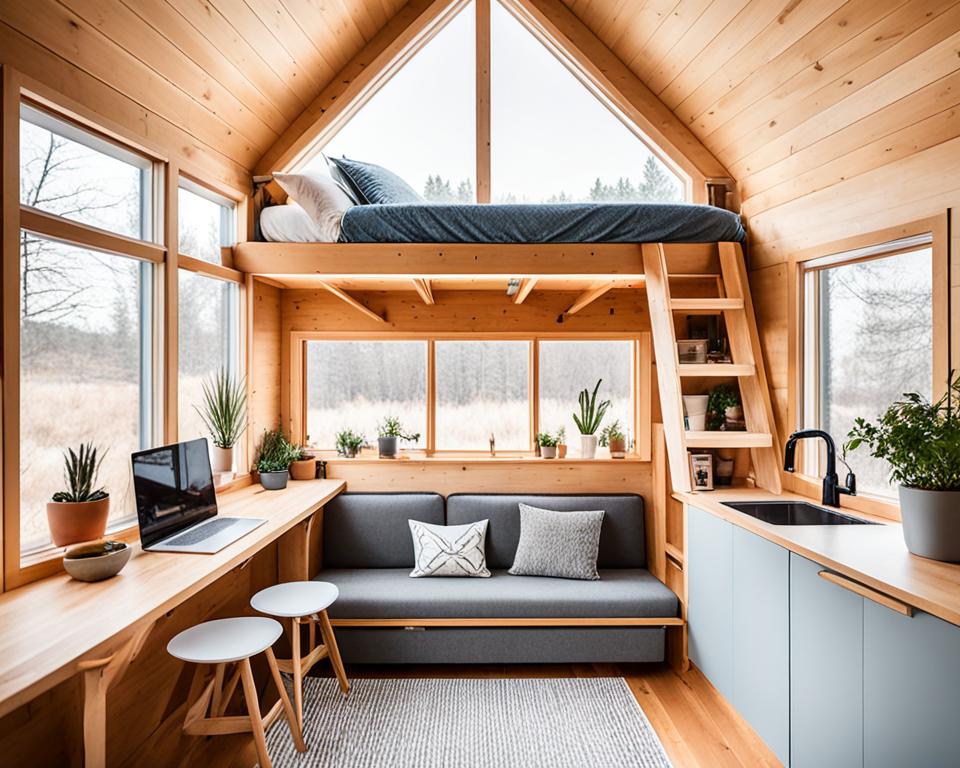The trend of living in a tiny house cabin is more than a trend. It’s a step towards sustainable living and freedom from big mortgages. People are finding peace in small cabins in nature. These homes show how smart design can make every inch count. They invite us into the off-grid cabin life we all dream of.
Building a DIY cabin or choosing a prefab one changes lives. It’s not just about saving space. It’s about living better with less. Tiny house communities show the true value of living simply. In these communities, sustainable living becomes our reality, not just a dream.
This guide looks at the benefits and challenges of tiny house living. It’s not about the size of our home. It’s about the limitless possibilities this lifestyle offers. For the adventurous, it’s time to ask, ‘Why haven’t we been living this way?’
Embracing the Tiny House Cabin Trend
The tiny house cabin trend is more than just a cute idea. It stands for compact living and financial freedom. This movement has grown worldwide. People everywhere are choosing to live simply and sustainably. This way, we find that less space actually means more life.
The DIY cabin trend draws us in. It’s a space for our creativity and reflects our style and needs. Living in these small spaces gets rid of unwanted clutter. This makes our lives simpler and full of joy.
Tiny house cabins mean more than just living in a small space. They represent a life free from too much stuff and high costs. Many of us desire to escape these burdens. A tiny home offers a way to live without debt, which is very appealing.
This interest in tiny homes isn’t just a phase. It brings back the old wisdom that less is more. Below is a table of the benefits that draw people to tiny house living:
| Feature | Benefits |
|---|---|
| Eco-footprint | Reduces environmental impact through sustainable practices |
| Affordability | Enables ownership without the weight of a mortgage |
| Community | Encourages close-knit, supportive social environments |
| Customization | Provides flexibility to design a space that reflects your personality |
| Freedom | Gives a sense of liberation from the consumerist lifestyle |
The tiny house cabin shows us a new way to live. It offers a simple, joyful life and cares for the environment. These homes promise a life that is happy and free, thanks to minimalist living.
We’re about to explore compact living in a big way. Although it may seem small, this journey offers vast happiness and freedom. Let’s discover the tiny house cabin movement together. We’ll see why small is the new big in living sustainably.
The Allure of Minimalist Living in a Tiny House Cabin
The mix of minimalist living and the allure of a tiny house cabin could be the key to financial freedom. This approach to living goes beyond just living in a smaller space. It’s about choosing a lifestyle that improves life quality and connects us with nature. These small homes bring big benefits, promoting sustainable living and well-being.
Financial Freedom with Tiny Cabin Homes
Picture a life free from a big mortgage. That’s what a tiny house cabin offers. Downsizing means a more affordable lifestyle, paving the way to financial freedom. Along with a lower buying price, you’ll spend less on bills and upkeep. This leads to a life where you’re not tied down by money matters.
Connecting Deeply with Nature
Compact living means more than just a smaller home. It’s about living closer to nature. A tiny cabin encourages you to enjoy the outdoors. This connection enhances our lives, making them healthier and filled with the joy of nature’s simplicity.
Lifestyle of Simplicity and Contentment
A tiny house cabin is more than a home. It’s choosing a simple, meaningful life. With fewer things to worry about, we find peace and purpose. Our homes become our sanctuaries, showing our true selves without clutter or complexity.
| Benefits of Tiny House Cabins | How They Enhance Life |
|---|---|
| Affordability | Opportunity to live mortgage-free, increased savings |
| Eco-Friendly | Less resource consumption, promotes sustainable living |
| Proximity to Nature | Encourages outdoor activities, connecting with nature |
| Simplified Lifestyle | Reduces stress, declutters mind and space for minimalist living |
In summary, a tiny house cabin represents a minimalist yet fulfilling lifestyle. It’s not just a trend but a deeper philosophy. Our cabins are more than houses; they are symbols of an intentional life. They embody our wish for financial freedom, a strong connection with nature, and true happiness.
Who Thrives in Tiny House Cabin Living?

Tiny house cabin living is more than a trend; it’s a lifestyle choice that fits many people. Those seeking a sustainable living environment find it ideal. It offers a chance to live minimally and be part of a close community.
Small cabins are perfect for hunters needing a simple and efficient base. Outdoor enthusiasts benefit too, spending less time on chores and more in nature. They cherish the practicality and adventure these small homes provide.
Homeowners with not enough space for guests see tiny homes as a smart fix. A cozy cabin can become a guest house or a rental for extra cash. This solution is both charming and economical.
Tiny cabins help those caring for elderly relatives by offering customizable and stylish living spaces. These homes ensure independence and dignity in a compact form. They blend comfort with personal flair seamlessly.
Tiny house cabins embrace everyone, from creatives to adventurers to caring family members. They support sustainable living and a minimalist lifestyle. This living option is open to all, showing the power of personalized and inclusive design.
Decoding the Costs of a Tiny House Cabin

Talking about tiny house cabins means looking at costs closely. It’s important to see how money affects moving to this lifestyle. We’ll explore both starting expenses and the savings over time. This will show us the real cost and the money-saving benefits of tiny cabins.
Initial Costs: Acquiring a Prefab Cabin Shell
Buying a prefab cabin shell is the first big step. These shells are the base of our tiny house, and prices can really vary. You might pay between $6,000 to $12,000 for one. The price depends on size and design, but it’s cheaper than buying a big house.
Interior Finishing: Budgeting for the Customization Process
After getting the shell, we customize the interior. This part lets us make the tiny house fit our style and needs. How much we spend here ranges from $7,000 to over $60,000. The cost changes with our choices in materials, appliances, and craftsmanship level.
Long-Term Savings: The Economic Advantages of Going Tiny
Living in a tiny house cabin saves us money in the long run. We’ll find our bills for things like utilities and maintenance go down. This saving gives us more freedom in life. We can spend on what we love, like hobbies and travel, instead of just house costs.
In the end, the path to tiny house living has its costs and savings. Our initial expenses lead to big savings and benefits over time. By planning our budget well, we choose a life rich in experiences, not just things. Choosing a tiny house is a smart financial move for a freer, fuller life.
Designing a Compact and Functional Tiny House Cabin Interior

Discussing tiny house cabin design means finding a balance. We aim for an interior that is both useful and beautiful. A well-arranged area offers comfort and stands for sustainable living. By checking out many tiny home design ideas, we find cool yet practical solutions for tiny spaces.
Inspirational Ideas from Existing Tiny House Cabin Interiors
Starting our tiny house cabin project, we look for inspiration everywhere. Envision the cozy light from LEDs or smart multi-use tables. It’s more than just nifty gadgets. It’s about crafting a space that’s simple and works well.
Maximizing Space with Smart Layout Strategies
We use smart layout ideas to use space wisely. Consider going vertical with bunk beds or tall shelves. This approach makes rooms seem bigger. Any small spot can turn into useful storage or an extra seat with creativity.
Selection of Appliances and Furniture for Small Spaces
Choosing compact appliances and versatile furniture for small spaces is key. Picture a small kitchen with a two-burner stove or a sofa that becomes a guest bed. Picking the right appliances and furniture means embracing a lifestyle where less gives you more—more room, more savings, and more happiness.
| Feature | Benefits | Example Product |
|---|---|---|
| Multifunctional Furniture | Saves space, serves multiple purposes | Convertible Sofa Bed with Storage |
| Compact Appliances | Energy-efficient, fits in tight spaces | 24″ Slim-Fit Refrigerator |
| Vertical Storage | Maximizes unused vertical space | Wall-Mounted Shelves |
| Smart Layout | Enhances flow, reduces clutter | Custom-Fit Slide-Out Tables |
| Eco-Friendly Materials | Supports sustainability, durable | Bamboo Countertops |
Taking on a tiny home design is about more than just going smaller. It’s about living with purpose. By carefully choosing our layout and furniture, we make a space that fits our needs and eco-friendly goals. It lets us enjoy the perks of tiny home life: simplicity, freedom, and being closer to nature.
Making the Most of Outdoor Living with a Tiny Cabin
We love the way our tiny house cabin flows from inside to outside. Our design invites us to enjoy nature fully. From enjoying morning coffee on a deck to stargazing in a hammock, our outside space is key. It’s not just extra; it’s a key part of living close to nature, where al fresco living enhances our connection.
Tiny living means being smart with space, especially off-grid. We use high ceilings and big windows to make indoors and outdoors blend. This design makes our small space feel bigger and keeps us close to nature. It shows that choosing to live simply gives us freedom, with nature’s soundtrack in the background.
We believe in simple living and deep connections with our surroundings. Our outdoor spaces bring us closer to others in the tiny house community. They also show our commitment to eco-friendly living. Life here follows the seasons, with wilderness just a step away. Our tiny cabins let us enjoy the outdoors deeply and without interruption.

